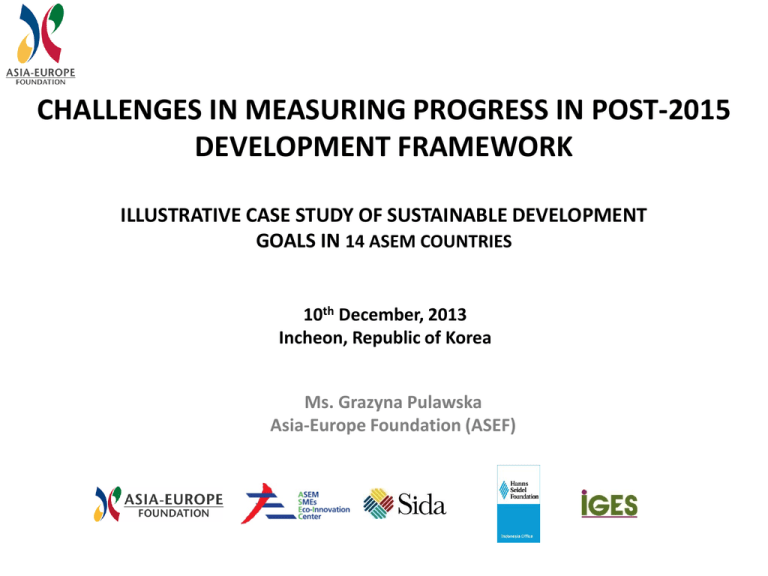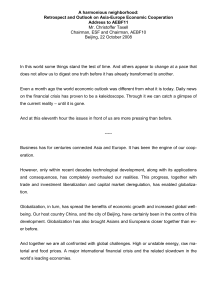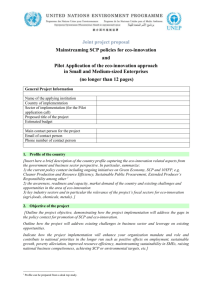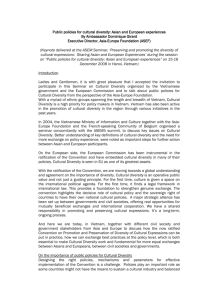
CHALLENGES IN MEASURING PROGRESS IN POST-2015
DEVELOPMENT FRAMEWORK
ILLUSTRATIVE CASE STUDY OF SUSTAINABLE DEVELOPMENT
GOALS IN 14 ASEM COUNTRIES
10th December, 2013
Incheon, Republic of Korea
Ms. Grazyna Pulawska
Asia-Europe Foundation (ASEF)
Overview
•
•
•
•
•
Introduction
Methodology
Objectives
Indicators
Conclusions
2
ASEF’s mandate to work on SDGs
9th ASEM Summit in Laos in 2012:
“Leaders reaffirmed their commitment to achieve sustainable development,
sustainable economic growth, social development and environmental
protection. They underlined the importance of finalisation of the UN
sustainable development goals through a transparent and inclusive intergovernmental process (…), in keeping with the outcome of the Rio+20
Conference on sustainable development. These goals should be coherent with
and integrated into the United Nations development agenda beyond 2015”.
ASEF 3-year programme:
a series of activities aiming at elaborating a set of SDGs and associated
indicators
3
Asia-Europe Environment Forum
• partnership of the Asia-Europe organisations
• Asia-Europe Foundation (ASEF), the ASEM SMEs EcoInnovation Center (ASEIC), the Swedish International
Development Cooperation Agency (SIDA), the Hanns Seidel
Foundation (HSF), the Institute for Global Environmental
Strategies (IGES),
• advisory committee consisting of representatives from
EU&EEA, ASEAN and recognised think tanks from Asia and
Europe
Geographic scope: ASEM Members
ASEM currently has 51 partners: 49 countries and 2 international
organisations.
• The partners: Australia, Austria, Bangladesh, Belgium, Brunei,
Bulgaria, Cambodia, China, Cyprus, Czech Republic, Denmark,
Estonia, Finland, France, Germany, Greece, Hungary, India,
Indonesia, Ireland, Italy, Japan, Republic of Korea, Laos,
Latvia, Lithuania, Luxembourg, Malaysia, Malta, Mongolia,
Myanmar, the Netherlands, New Zealand, Norway, Pakistan,
the Philippines, Poland, Portugal, Romania, Russia, Singapore,
Slovakia, Slovenia, Spain, Sweden, Switzerland, Thailand, the
United Kingdom, Vietnam
• Organisations: European Union and ASEAN Secretariat
Post 2015 / SDGs are meant to be:
Action
oriented
Aspirational
Concise
Reflecting
national
differences
Easy to
communicate
Global in
nature
Limited in
number
Universally
applicable
6
ASEF Study: “SD Goals and Indicators for a Small Planet”
Objectives
1.
Develop and test a methodology in selected Asia-Pacific and European
countries to identify a system of SDGs, and to provide guidance for the
methodology’s broader application at the global and national levels.
2.
Identify illustrative SDGs and underlying targets and indicators that are
guided by global and informed by national priorities as expressed in
existing national SD Strategies and National Development Plans.
3.
Provide countries in Asia-Pacific and Europe a foundation for
developing their own SDG and indicator sets by producing national
thematic templates that reflect their respective priorities, goals, targets
and indicators.
4.
Support the implementation of SDGs by providing guidance regarding
their integration into policies and programs.
7
Our small(er) planet
France
Germany
Hungary
Poland
Sweden
Switzerland
Australia
Bangladesh
China
India
Indonesia
Japan
Republic of Korea
Singapore
8
Components of the SDG ‘package’
SDG component
Goal
Sub-goal
Target
Indicator
Representation
Goal statement: the general
area of concern
Sub-goal statement: what is
the specific aspiration
Where to aim
How to measure
10
The System Approach facilitates the categorization
of goals and priorities
The Ultimate Means-Ultimate Ends tool enabled the integration of
the 3 SD pillars in each goal and guided the proper placements and
order of goals and priorities
11
The 10+1 Priority themes + Goal statements
1. Poverty and inequality
Poverty and inequality are reduced
2. Health and population
Population is stabilized and universal access to basic health services is
provided
3. Education and learning
Education is a major contributor to the sustainability transformation
4. Quality of growth and
employment
Economic growth is environmentally sound and contributes to social wellbeing
5. Settlements, infrastructure
and transport
Settlements with their infrastructure are liveable, green and well-managed
6. SCP and economic sectors
Resource efficient and environmentally friendly production and consumption
characterize all economic sectors
7. Food security, sustainable
agriculture and fisheries
Sustainable agriculture, food security and universal nutrition have been
achieved
8. Energy and climate change
Climate change is effectively addressed while access to clean and sustainable
energy has been significantly improved
9. Water availability and access
Safe and affordable water is provided for all and the integrity of the water
cycle is ensured
10. Biodiversity and ecosystems
Biodiversity and ecosystems are healthy and contribute to human well-being
+1 Adaptive governance and
means of implementation
Adequate structures and mechanisms are in place to support the
12
implementation of the priorities underlying the SDGs at all levels
Ultimate ends
1. Poverty and inequality
2. Health and population
3. Education and learning
Human and planetary well being
Intermediate ends
4. Quality of growth and employment
Human capital and social
capital
Intermediate means
Built capital and social capital
Ultimate means
5. Settlements, infrastructure and transport
6. SCP and economic sectors
7. Food security, sustainable agriculture and
fisheries
8. Energy and climate change
9. Water availability and access
Natural capital
10. Biodiversity and ecosystems
+1 Adaptive governance and means of implementation
Beyond MDGs: Focus on Structure of the Economy
14
China example:
Investment and innovation for green and circular economy has
been significantly increased
Goals
Targets
Indicators
15
Germany example:
Investment and innovation for green and circular economy has
been significantly increased
Goals
Targets
Indicators
16
Example of available indicators for ASEM
6.4 Investment and innovation for green and circular economy has been significantly
increased
[OECD]
Number of
patenting coinventors in
green
technologies
[Eurostat]
Employment in
the
environmental
goods and
services sector
v
v
v
v
v
v v
v v v v v v
v v
v v v v
v
v
v
v
v v
v
v v v
v
17
ASEI
18
ASEM ECO-INNOVATION INDEX - ASEI Framework
Framework and indicators differ depending on where the focus lies :
Looked at recent academic literatures and reports (e.g. Javier), Current national and
regional trends & initiatives (e.g. OECD), Proposed framework and indicators (e.g. UNUMERIT, EIO), Related Indexes (e.g. EPI, GII)
OECD Green Growth Measurement (2012)
Eco-Innovation Scoreboard (2012) EIO
European Environment Agency:
Eco-innovation indicators (2006)
Global Cleantech Innovation Index (2012)
© Sustinvest. 2013. All rights reserved
Strictly Private & Confidential
ASEI
No agreement hitherto exists on a set of indicators that accurately
measure eco-innovation
Thus, ASEI is an evolving project which will always carry room for
improvement
ASEI shows on a handful of proposed indicators for eco-innovation
There have been few cases where a preliminary set of ecoinnovation indicators was proposed but actual measuring procedure
had been neglected.
• Only Eco-innovation Scoreboard (EIO-IS) quantitatively measures
eco-innovation at national level
20
The ASEI Project
Where does ASEI focus lie?
Covers a comprehensive yet manageable body
of information on core eco-innovation issues
e.g. green technology, environmental R&D
expenditure, green market
Capacity
Institutional Framework Supporting Environment
© Sustinvest. 2013. All rights reserved
Strictly Private & Confidential
ASEM EcoInnovation Index
Four Criteria
Twenty Indicators in total
© Sustinvest. 2013. All rights reserved
Strictly Private & Confidential
To measure eco-innovation of a country the following key indicators & themes are
looked at
Criteria
Indicators
1.1 County’s Economic Competitiveness
1.2 Country’s General Innovation Capacity
1. Eco-Innovation
Capacity
1.3 Green Technology possessed/acquired Firms
1.4 Green Technology R&D Institution Capacity
2nd ASEM Ecoinnovation Index
1.5 Awareness of Sustainability Management
2.1 Government’s R&D Expenditure in Green Industry
2. Eco-Innovation
Supporting Environment
2.2 Implementation of Environmental Regulations
2.3 Maturity of Investment Setting for Green Technology Industry
2.4 Investment Scale towards Green Technology SMEs
© Sustinvest. 2013. All rights reserved
Strictly Private & Confidential
Criteria
Indicators
3.1 Commercialization Level of Green Technology
3.2 Firms’ Participation on Environmental Management System
3. Eco-Innovation
Activities
3.3 Economic Influence of Leading Environmentally Responsive Firms
3.4 Green Patents
3.5 Activeness of Renewable Energy Utilization
2nd ASEM Ecoinnovation Index
4.1 Level of Environmental Impact on Society
4.2 CO2 Emission Intensity
4. Eco-Innovation
Performance
4.3 Country’s Energy Sustainability level
4.4 Water consumption intensity
4.5 Jobs in Green Technology Industry
4.6 Green Industry Market Size
© Sustinvest. 2013. All rights reserved
Strictly Private & Confidential
Some Lessons
1. Use simple language and ensure common
understanding of terminology
2. There is no generally right way of ‘cutting the cake’.
Logic and consensus must always be exercised
3. There will always be tension between
comprehensiveness and manageability
Avoid the trap of covering all issues that can result
in very long and unwieldy SDG set
25
C o nt ra c t i o n a n d c o nve rge n c e
26
National sustainability dashboard
• Purpose is to strengthen effectiveness and transparency in
SDG implementation
• Grounded in global goals and subgoals as common elements
• Customized as and where required to the national context
based on targets and indicators
• Directly linked with existing national data systems (statistical
and remote sensing)
• Has an easily understandable, transparent, user-friendly
interface
• Serves the information needs of implementation mechanisms
• Dynamically updated and revised as required
27
28
G o a l s and S u b – g o a l s
Targets
Indicators
29
Dashboard of Sustainability
Source: http://esl.jrc.ec.europa.eu/envind/dashbrds.htm
30
ENVforum 2013 - 2015
•
•
•
•
Continuation of research on SDGs in ASEM countries
Knowledge management
Information tailored to target group
Multi-stakeholder consultation
Specifically:
• Indicators for SD
• Governance & Financing












